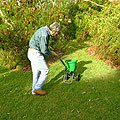The November edition of the Burke’s Backyard magazine includes a 20-page guide to creating gardens that really are low maintenance. The guide goes through all the elements of a garden, distinguishing those that are easy-care from those that mean work such as lawns and water features. The guide also looks at plants, the impact of pets, weeding and how to avoid it, good watering and how to use mulches. In our television segment Don discussed several ways to cut down on garden maintenance, but you’ll find many more tips and ideas in the magazine.
Get rid of the lawn
Lawn is the most work-intensive part of any garden. It regularly needs mowing, edging, aerating, fertilising and spraying for weeds such as bindii. Your best option is to go to paving, and/or to increase the size of garden beds and shubberies. However, if you want to keep the lawn, make sure that you put in solid edging to make mowing easier and prevent grass from growing into the garden beds.
Problem pools and ponds
As much as Don loves water features, he says they can become a garden maintenance nightmare. Problems can arise with pumps, lights and with fish. Koi carp are probably the dirtiest fish of all – they pollute ponds and turn the water green. Swimming pools are even higher maintenance than ornamental pools. Pumps need servicing, filters cleaning and pipes unblocking. The water in a swimming pool must be kept clear, automatic pool cleaners often need attention, and you must chlorinate the water to prevent algae growing on the sides and the bottom of your pool.
Australian native plants
It is a myth that Australian native plants are low maintenance. Australian natives need regular attention, and must be fertilised, watered and pruned if you want them to look their best. Some species, such as boronias, are short lived and have to be replaced often.
Topiary and hedge
alternativesAny plant that needs constant trimming is not low maintenance. If you want a hedge in your garden, your best low maintenance option is to choose a plant that naturally grows to the height you’re after. If you like the look of topiary but don’t want to spend all your spare time keeping it in shape, consider conifers such as Spartan juniper (Juniperus virginiana ‘Spartan’) which grow naturally into a pleasing, conical shape.
Further reading
See the bonus 20-page section on low maintenance gardens in the November edition of the Burke’s Backyard magazine. The magazine is available at newsagents for $4.80.



